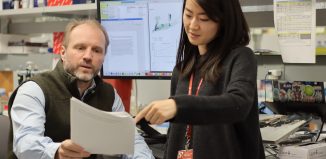Finding a quirk in the world of matter
Coming from an international team of researchers out of Japan, physicists confirmed a small, but potentially powerful, quirk in the world of matter. If, as they believe it may, those small details don’t behave in the same way with antimatter, this finding could help explain how tables, chairs, lions and bears all exist.
They are focusing on neutrinos, which are so small that 50 billion of them pass through a finger in a second. Most neutrinos come from the sun, although scientists can produce them in a lab and shoot them underground to a detector miles away. In the case of T2K, scientists sent neutrinos 185 miles from Tokai village along the east coast of Japan to Kamioka, near the west coast of Japan.
Neutrinos come in three types: tau, muon and electron. The scientists shot muon neutrinos across Japan and expected, for the most part, to find tau neutrinos. Confirming with a much higher degree of accuracy a discovery from 2011, scientists found that 5% of those neutrinos became electron neutrinos.
“Nature was kind to us,” said Chang Kee Jung, a co-spokesman for T2K and a physics professor at Stony Brook. The oscillation to electron neutrinos “came out much earlier” than expected. So far, the scientists have only examined about 8% of the data they proposed to generate.
The next step in this long-term project is to collect considerably more data to explore on a larger scale the oscillations between muon and electron neutrinos.
Later, in Japan and elsewhere, scientists plan to conduct the same experiment with antineutrinos, to see if the transformation from one type of antineutrino to another follows the same pattern.
Like the conservation of energy, charge parity suggests the laws of physics would be the same if a particle were swapped for its antiparticle. In 1956, however, this was violated when several scientists showed that some reactions did not occur as often as their mirror images.
Scientists who work with particle physics were buzzing about the recent findings in Japan. “We at BNL are extremely thrilled at the T2K results,” offered Milind Diwan, a physicist at Brookhaven National Laboratory, who described Jung as “well recognized as a leader in our community.”
Jung marveled at the predictive ability of the science of physics. “When we observe certain things, we put all our observations and experimental data into mathematical equations,” he said. “Those equations will predict things we haven’t seen. We are almost the only science that has a predictable power using math.”
The Higgs particle, he said, was one such prediction physicists had been seeking for over 40 years. This particle provided something of an explanation for how particles with considerable energy acquired mass.
Jung expects to continue the T2K experiments for another five to 10 years.
At the same time, scientists including Diwan are working to turn the Long-Baseline Neutrino Experiment into a reality. The LBNE will shoot neutrinos 800 miles from the Fermilab near Chicago to a former gold mine in Lead, S.D. The experiment hopes to begin producing data in 2022.
An adventurer in his earlier years, Jung climbed mountains and went skydiving. In a physics of sports course he teaches at Stony Brook, he shows a video of himself on a tandem skydive in Florida with an instructor.
Jung also takes a close look at former Mets ace R.A. Dickey’s knuckleball, Usain Bolt’s 100-meter dash and the hang time of NBA basketball players.
An avid baseball fan who would choose the Mets over the Yankees because he loves the underdog, Jung considers himself a “hard-core Knicks fan.”
Jung is a resident of Setauket, where he lives with his wife, Vivan Piccone-Jung, who teaches Pilates and does video/film production and Web page design. The couple have three children, Daldeze, who attends Stony Brook, Wainabi, who will matriculate at SUNY New Paltz in the fall and Heoliny, who will be a ninth-grader at Murphy in September.
Jung has a picture in his office and on his website of him standing with the late Maurice Goldhaber, who was the director of BNL in the 1960s. A physicist in the generation immediately after Albert Einstein, Goldhaber visited Jung at his house on a day when it was raining. Standing in similar tan trench coats, the physicists are holding pink and red umbrellas, which they borrowed from Jung’s daughters.
“He’s willing to be silly and I have a similar spirit,” Jung said.
As for his work, Jung recognizes that there is “no guarantee” that scientists will discover CP violation when they look at antineutrinos, although he is “confident” it is there. Still, he doesn’t think he should “bet on this. I lost a few bets by betting on my New York Knicks, so my track record is not perfect.”






